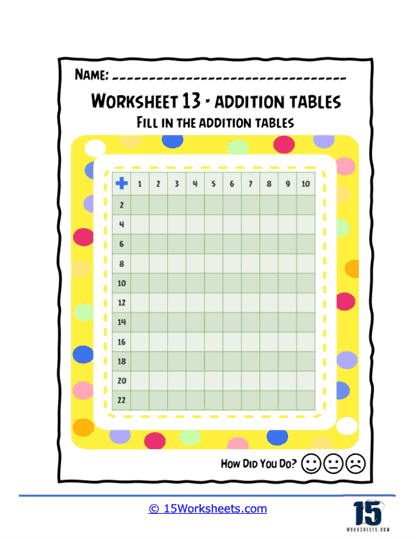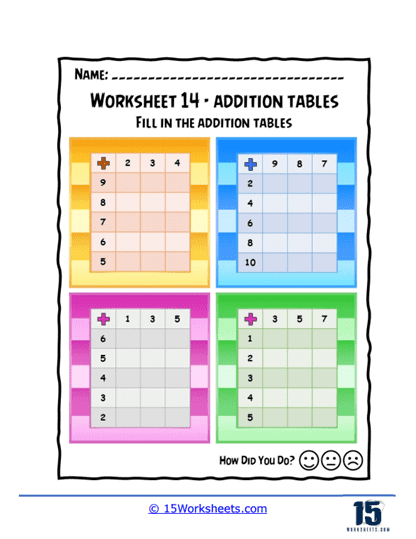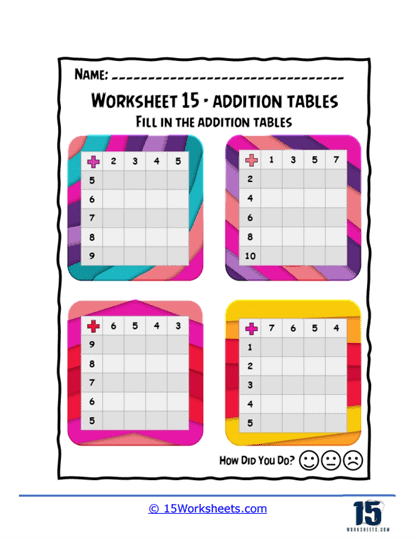Addition Tables Worksheets
About These 15 Worksheets
These worksheets provide structured exercises that systematically guide learners through the addition tables, from the simplest sums to more complex computations. By engaging with various types of exercises within these worksheets, students develop fluency, accuracy, and confidence in performing addition operations.
Addition tables worksheets typically consist of a series of exercises organized in a tabular format, with rows and columns representing numbers to be added. These worksheets are designed to cover a range of addition facts systematically, starting from basic sums and progressing to more challenging calculations. Each worksheet is tailored to cater to different skill levels, ensuring that students can gradually build upon their knowledge and understanding of addition operations.
Through a range of structured exercises targeting different skill levels and concepts, these worksheets provide opportunities for students to practice and reinforce addition skills systematically. By engaging with addition tables worksheets, students not only improve their computational fluency but also develop problem-solving abilities essential for success in mathematics and beyond.
Types of Exercises
Basic Sums – At the foundational level, addition tables worksheets introduce students to basic addition facts. These exercises involve adding single-digit numbers, such as 1 + 2, 3 + 4, or 5 + 6. Through repetitive practice, students familiarize themselves with these fundamental addition combinations, which form the building blocks for more complex calculations.
Sequential Addition – As students advance, worksheets may incorporate sequential addition exercises. These tasks require learners to add numbers in a sequence, such as adding by twos (2 + 2, 4 + 2, 6 + 2) or adding by fives (5 + 5, 10 + 5, 15 + 5). Sequential addition reinforces patterns in addition operations and helps students develop mental arithmetic skills.
Missing Addends – Another common type of exercise found in addition tables worksheets involves identifying missing addends. In these exercises, one of the addends is omitted, and students are tasked with determining the missing number to complete the addition equation. For example, given the equation 3 + __ = 8, students must identify that the missing addend is 5.
Doubles and Near Doubles – Doubles and near doubles exercises focus on addition facts where both addends are the same or nearly the same. For instance, students may practice sums like 6 + 6 or near doubles like 7 + 8. Mastering doubles and near doubles not only reinforces addition fluency but also aids in mental calculation strategies.
Regrouping – More advanced addition tables worksheets may include exercises that require regrouping or carrying over. These tasks challenge students to add multi-digit numbers, such as 47 + 58 or 132 + 89, where regrouping is necessary to find the correct sum. Regrouping exercises foster an understanding of place value and strengthen students’ computational skills.
Speed Drills – Speed drills are timed exercises designed to assess and improve students’ fluency in addition operations. These drills typically involve a series of addition problems to be solved within a specified time limit. Speed drills challenge students to recall addition facts quickly and accurately, promoting automaticity in arithmetic calculations.
The Benefits of Addition Tables Worksheets
Engaging with addition tables worksheets offers numerous benefits for students as they develop their foundational math skills:
Mastery of Addition Facts
Regular practice with addition tables worksheets enables students to memorize and internalize addition facts. By repeatedly solving a variety of addition problems, students become fluent in performing basic addition operations without relying on finger counting or other aids.
Through exposure to sequential addition, doubles, and near doubles exercises, students enhance their mental arithmetic abilities. They learn to recognize patterns, make connections between numbers, and perform calculations mentally, thereby increasing computational efficiency.
The structured nature of addition tables worksheets facilitates the development of mathematical fluency. As students progress through various types of exercises, they gain confidence in their ability to perform addition operations accurately and efficiently.
Enhanced Problem Solving Skills
Addition tables worksheets, particularly those incorporating word problems, promote problem-solving skills. Students learn to apply addition concepts to real-world situations, analyze information, and devise strategies to solve mathematical problems effectively.
Proficiency in basic addition operations lays a strong foundation for future mathematical learning. By mastering addition facts and computational skills early on, students are better equipped to tackle more complex mathematical concepts and problem-solving tasks in higher grades.















